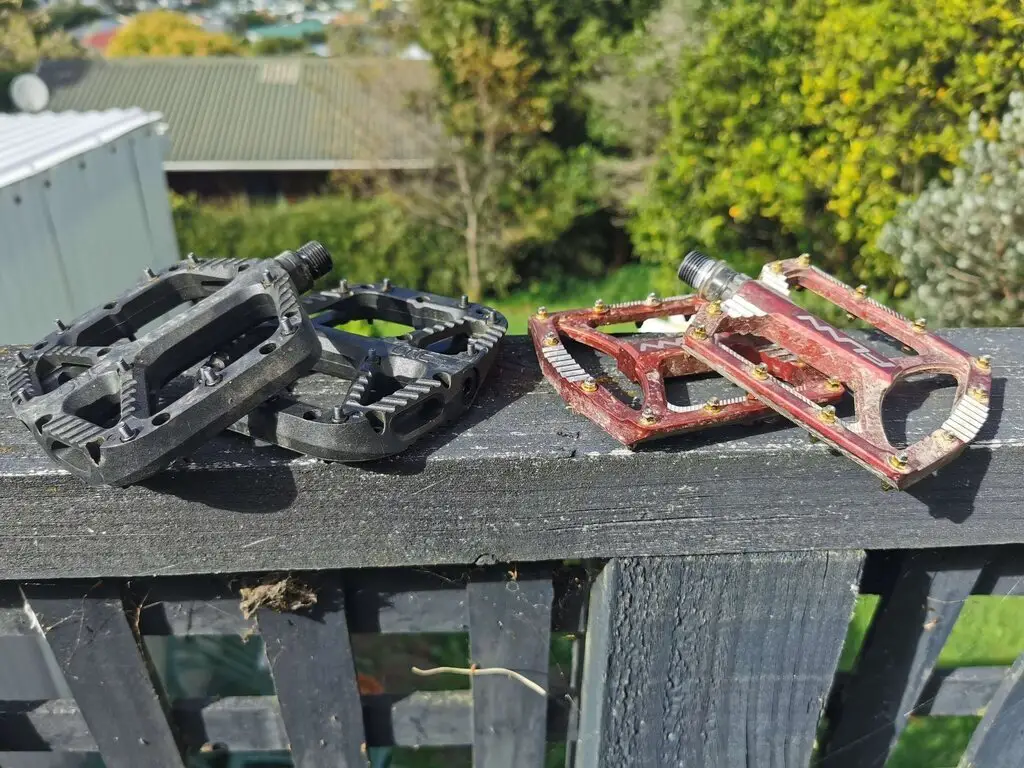Flat mountain bike shoes look super simple, right? Well, there’s a heap going on behind the scenes, and making flat pedals is more of a dark art than a science. Here we cover all the different components in a comprehensive guide that will leave you as an expert on flat pedals.
I have recently made the switch to riding flats full time again, and I can say even as an experienced rider, they are a heap of fun, and I have am loving them! So kick back, and let’s explore the art that is flat mountain bike pedals.
Budget
We’ll start with probably the most important factor, and that is your budget. It is essential to stick to whatever you decide to make sure you can afford the rest of the gear that you need!
With MTB flat pedals, your budget will have the most significant effect on the material and bearings. We go into more depth on these later, but…
Essentially a lower budget will mean you are looking at composite pedals rather than alloy pedals that come at a bit more of a premium. Both are great in their own ways, so check out what we have to say later in the article.
It is also worth noting that if your budget doesn’t include a pair of mountain bike-specific shoes, it could be worth adding it in as they make a big difference to your riding! Again check out the shoe section later on in the article for more.
Pedal Material
There are two common materials used in flat pedals these days: aluminum pedals and composite pedals. You can get magnesium flat pedals that are super light for the super high-end pedals but come at a considerably higher price. You’ll also find some expensive lightweight pedals that will offer titanium bearings, which essentially just reduces the weight compared to standard steel bearings. Be careful with titanium bearings as they often have a weight limit on them.
Aluminum
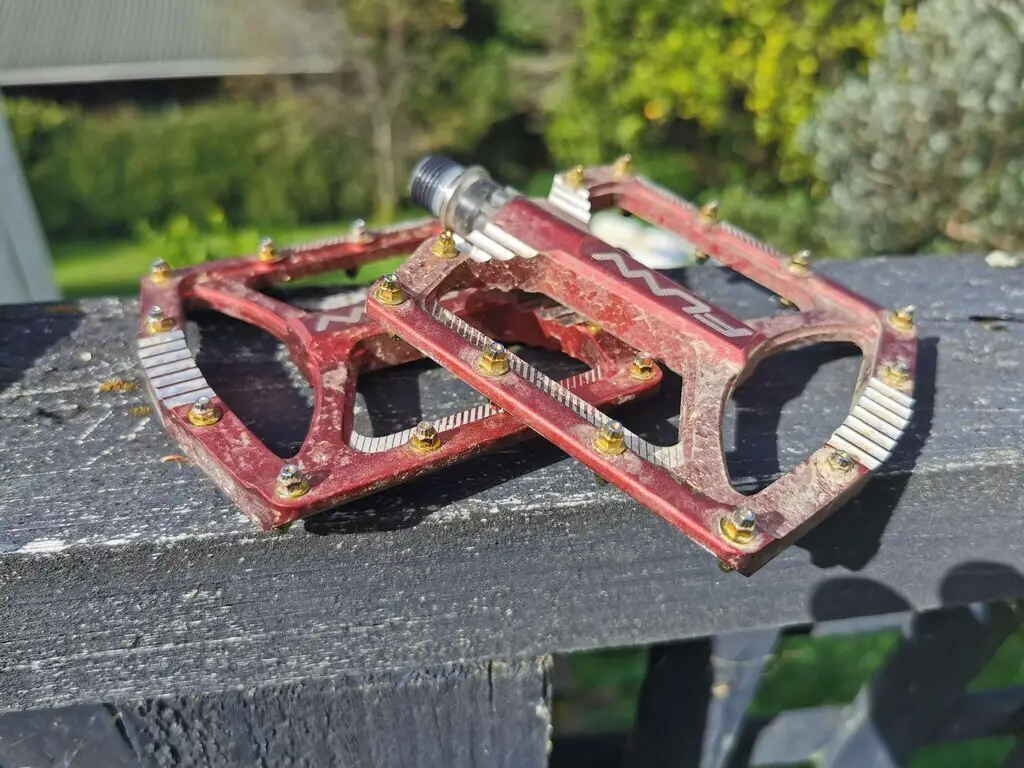
Aluminum flat pedals are usually CNC machined alloy shaped up and typically consist of replaceable and adjustable pins.
One significant advantage of alloy pedals is their looks. Some of them look stunning. With their clean CNC finish on a pedal, you just can’t beat it!
Another benefit is that alloy pedals are usually considerably thinner than composite pedals. Flat pedals are generally quite big, and that can mean you are more prone to rock strikes, so the thinner the pedal, the less you will have. Speaking of rock strikes, alloy pedals hold up much better for those more significant hits, as it is a more durable material.
Another benefit is how stiff alloy pedals are compared to composite. A stiffer pedal does mean you’ll get better-pedaling efficiency. However, on the other hand, rock strikes are much more brutal, as the material doesn’t soak up any of the impacts.
With most alloy MTB flat pedals, the pins are usually both adjustable and replaceable. We’ll go into more depth on this later. Still, it means the level of grip is more adjustable, and the pedals will last longer.
But alloy pedals’ biggest drawback is the price. They are much more expensive than composite pedals, for what is a good boost in performance, but it’s not to say that composite pedals don’t do a great job as MTB pedals.
Composite
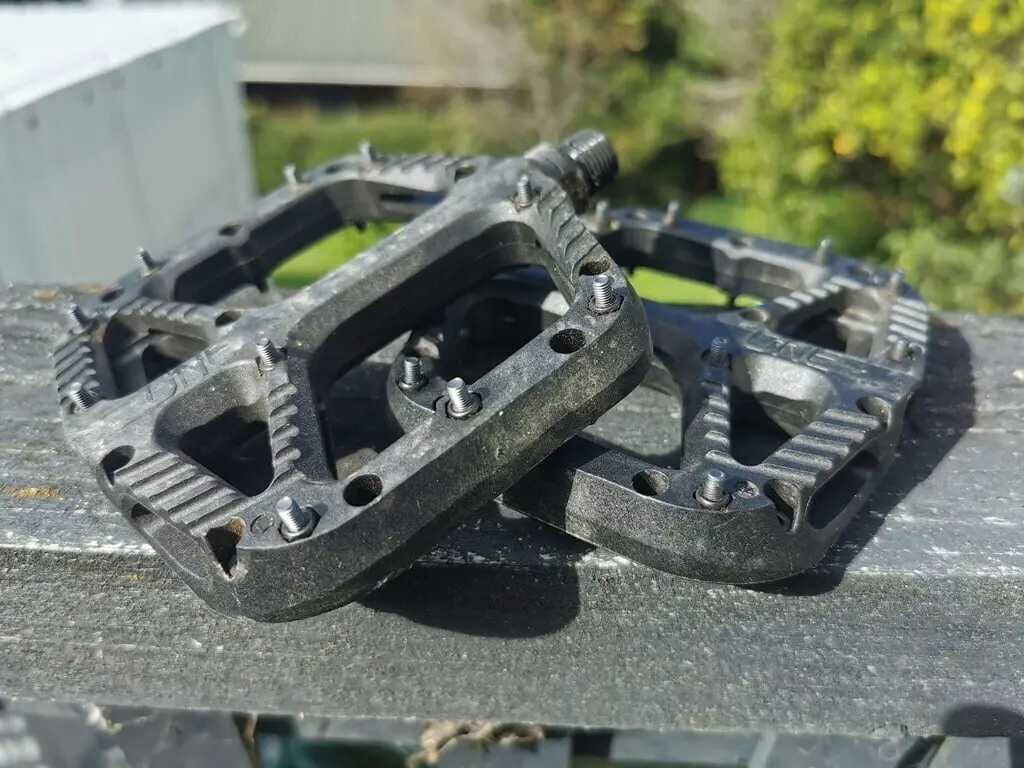
Composite pedals have come a long way in recent years and have really taken off in the mountain biking community. They have gone from being a kids-only option with just a plastic mold construction with no durability. They are mostly made of a nylon composite that feels extremely solid and features removable and adjustable pins.
First, let’s get stuck into one of the biggest benefits of composite pedals, which is the price. They are more often than not based on the alloy version, so they feature the same premium internals but come at a fraction of the cost and are usually lighter.
That all sounds too good to be true, and there are a few drawbacks to composite pedals, but none of them are considerable enough to discard them as an option.
The first is that they need to be thicker than their aluminum pedals. It can be pretty noticeable on some models and result in more rock strikes if you ride in areas prone to it.
Speaking of rock strikes, the softer nylon compound is much nicer to hit rocks on as it absorbs some of the shock that goes through the bike. However, composite compounds are not as durable as alloy, so you are more likely to destroy your pedal on rocks. In saying that, I have had a few good strikes on composite pedals and haven’t had an issue yet.
Durability is the other concern with composite pedals. However, the premium modern pedals like those from OneUp and Crankbrothers feel very solid and have serviceable high-quality bearings. But the composite construction won’t hold up to the kind of treatment that alloy pedals can.
Sum Up
So, in terms of the material you are looking for, both are great options, and your decision will probably be based on your budget. Alloy pedals are the more premium option and have a number of benefits, like being thinner, more durable and better looking. But modern composite pedals are no slouch, and you can get a premium pedal with tons of grip for a great price. Now that’s worth considering.
We’ve gone into more detail about this in our composite vs aluminum pedals article.
Platform Size
When it comes to pedals, size matters! It can be easily overlooked as not important, but it is a serious consideration when buying pedals. So much so that companies like Crankbrothers offer both a small and large size platform for their pedals.
The size of the pedal that you want will be determined by the size of your feet. The larger your feet, the larger the pedal you want. This is because you want to make sure your feet don’t slip off the pedals. After all, you don’t want them too small, but you also don’t want to have them too big so you don’t use all the pins on the pedal. Pedals are designed with the assumption that your shoe will fit over all the pins to get the optimum grip.
Nowadays, the benchmark size for a pedal platform is around 100×100 mm. Unless you have small feet, you wouldn’t want to go smaller than this.
A pedal that fits correctly should distribute your weight evenly and make sure you are using all the pins available. For more on this, check out our guide to pedals for those with large feet.
Platform Shape
The shape of flat pedals is a hot topic, but it all comes down to where and what you will be riding. How you like to ride will also come into it as some shapes give more grip than others.
Concave vs. Convex
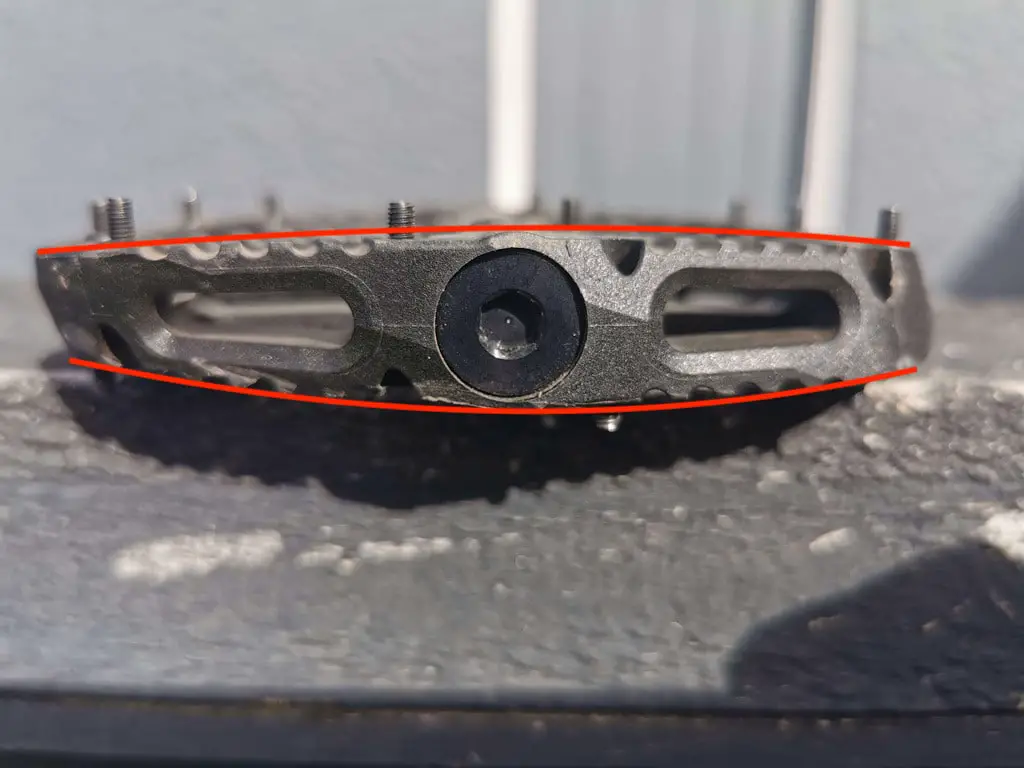
Although the pedals are referred to as flat pedals, it is not strictly true. Many pedals are not flat but have a bit of concavity or convexity to them.
A concave shape is the more common pedal shape and is where the pedal sags in the middle creating a bowl shape. The benefit to this is that your feet sink right into the center of the pedal, and it effectively cups your shoe. This holds your foot solid in place with the pins ensuring you’re locked in.
A convex shape is the alternative where the pedal bulges out in the middle. It is less common and certainly won’t be as extreme as the concave pedals as they tend to be flat to slightly convex. The benefit to a convex shape is that it allows you to adjust your feet much easier, and the traction pins then lock it into place.
In summary, those that like to be locked into the pedals should go with a more concave shape like the Deity TMac pedals. Whereas those that like a bit more freedom to adjust their feet on the pedals should go for a flatter/convex shape that will allow for this.
Thin or Thick
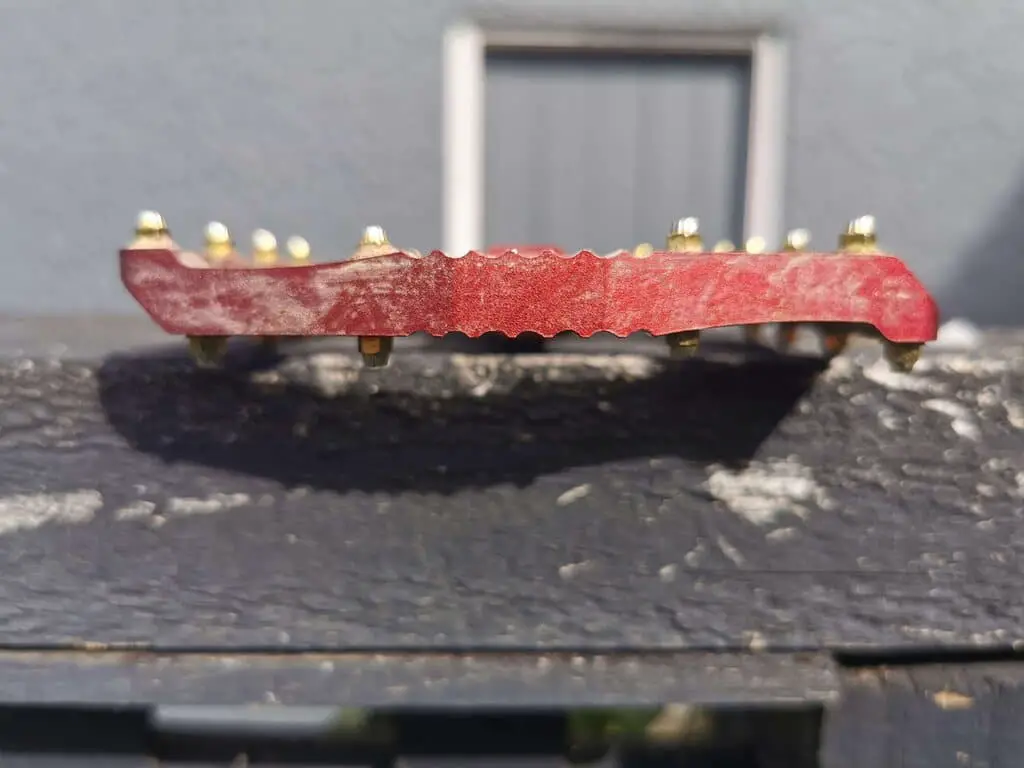
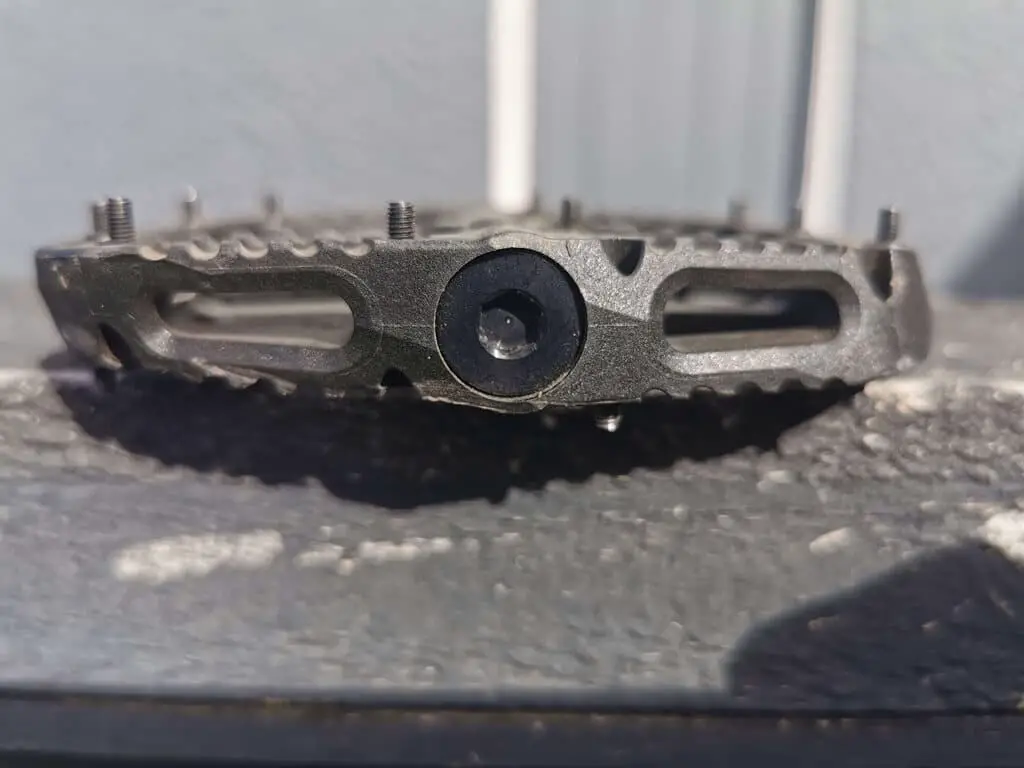
The other consideration when it comes to the shape of flat pedals is the thickness. First, let’s get into why it matters. Due to flat pedals’ size compared to clipless pedals, they’re much more prone to rock strikes when out on the trails.
One way to mitigate this is to have super thin pedals that are much less likely to strike on rocks when out on the trails. However, typically thinner pedals come at a higher price, so this will be determined by your budget.
If you don’t ride in rocky areas, then a thin pedal is not as critical, and you could get away with a thicker pedal.
Ultimately, your budget determines whether rock strikes will be a problem for you out on the trails.
Pedal Traction Pins
Although pins may not seem like they will make much of a difference to your flat pedal riding, they have a huge influence, and there is a surprising amount to them.
First of all, is the pins’ size. Larger pins will give you more grip, providing you have a set of MTB-specific shoes that they can sink into.
Next are the shape and construction of the pins. Some pins are more aggressive than others. The sharper and harsher the traction pins, firstly, the more they will hurt if you smash your shins on them, but they will stick your feet to the pedals much better.
It is very common now for mountain bike flat pedals to have adjustable and replaceable pins. Meaning that you can change the level of grip that pins provide. When you get a big rock strike and damage the pins, you can simply replace them.
One thing you want to avoid is composite mountain bike pedals with the pins molded in with the pedal. They won’t be replaceable and will wear down much quicker than metal pins on the more premium pedals. Typically the molded pins don’t have the aggressive edge that pins need to stick to the shoes. They are often very slippery and won’t hold your feet, especially in the wet.
In summary, you want adjustable/replaceable pins that are aggressive enough for your personal preference on how much grip you like to ride with.
The Internals
As you go up in price the quality of the bearings increases as well. It is essential to consider if the bearings can be serviced and replaced. This can significantly increase the lifespan of the pedals.
Most premium pedals have rebuild kits that you can purchase, giving the internals a replacement and leaving you with a pedal that feels like new!
Another thing to look for in the pedals is to make sure they don’t have cheap bushings or bearings being used. These will go gritty feeling and rattly really quick, and that’s definitely not a good feeling.
Pros and Cons of Flat Pedals
We have a whole article dedicated to this topic, but I feel having a summary here will help a lot! So here is a quick overview of the pros and cons of flat pedals.
Pros
- Allows beginners to build confidence on the bike and learn how to ride without relying on being clipped into the pedals.
- You have the freedom to put your feet in any position you like and can change it to suit how you’re riding at the time.
- Less commitment is required when riding challenging trails as you always have an easy bail-out option.
Cons
- Your pedaling efficiency will significantly drop using flat pedals. The shoes have to be more flexible, and you can’t complete a smooth stroke.
- Harder to hold onto the bike when the trail gets rough.
It’s one of those parts of mountain biking that all comes down to personal preference and what level of riding you are at.
I have just switched from mainly riding clips to riding flats again and I am absolutely loving them! They’re a heap of fun, and it’s always good to learn to stop relying on clips again.
Flat Pedal Shoes
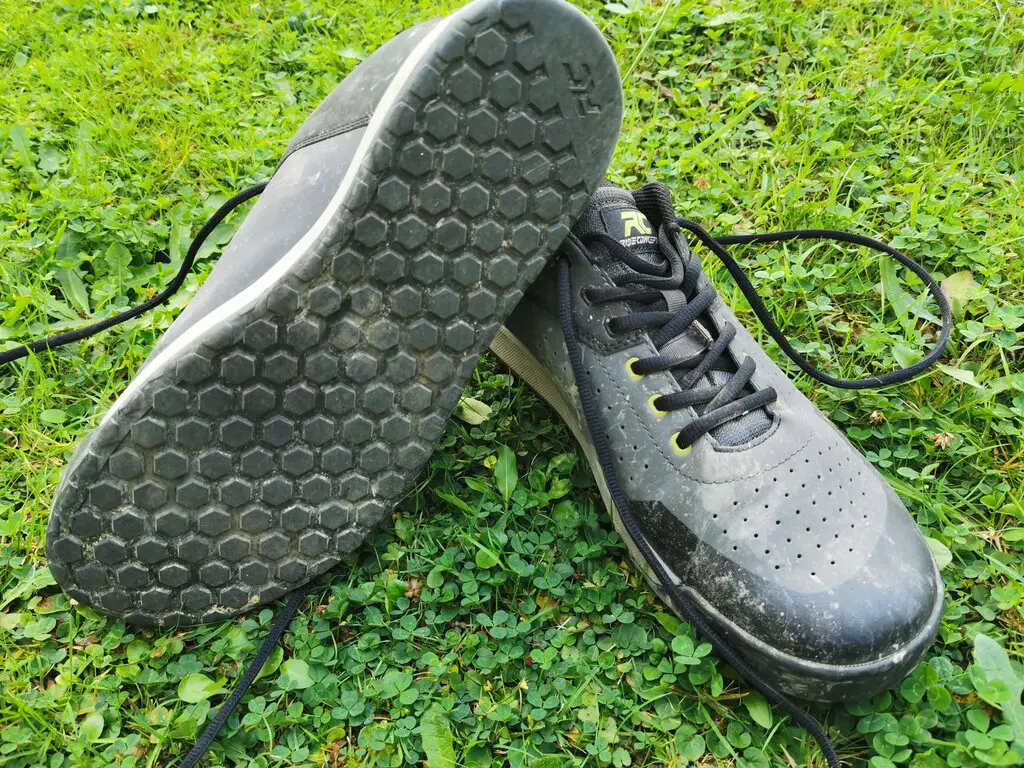
Although this is a flat pedal buyer’s guide, it would be incomplete if we didn’t touch on mountain bike shoes.
First of all, mountain bike pedals are designed to be ridden with flat pedal shoes with tough, grippy rubber that lets the pins stick into them without being destroyed straight away. Therefore, to get the most out of your riding, you need to use flat pedal shoes. From experience, I can say that it is incredible how much grip you can get from a set of flat MTB pedals.
Suppose you’re a beginner and not riding anything too crazy. In that case, you can get away with regular shoes for a bit, but it won’t take long until you want a set of MTB-specific shoes.
We believe shoes are such an important part we wrote an entire article going into the details of it here!
Conclusion
It’s incredible how much actually goes on with such a seemingly simple product: the flat pedal. As you can see, some features are a must and shouldn’t be compromised, but many others are a matter of preference.
Now you know what to look for in flat pedals, its time to create a shortlist and just get a set so you can get out riding!
